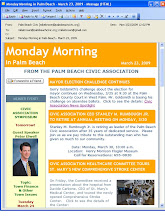I think we're in a great position to offer more for news and advertising. What do you think?
Our mantra at IBM in the 1980's was to change the communication world from one-to-many, to many-to-many communication, as we were inventing multimedia technology and predicting what the Web would become.
We believed that newspaper companies would either evolve into web-based media companies or not make it. When I showed Web prototypes to the NY Times in 1990, they just scratched their heads in amazement.
Back then, some said nobody would read that much on a computer screen. Now we watch our teenagers, heads bent over all the time, looking at a cellphone screen.
I’m just surprised newspapers haven’t totally switched or gone under yet.
TV has taken a long time to adapt because the engineering architecture of TV and a computer are completely different and incompatible; and, it’s taken a while for the network (transmission pipe) to get big enough and fast enough.
Radio and other audio were pretty easy to move to the web. I remember getting voiceover talent to come into our studio and do recordings. Now, most of the VO talent lives in Costa Rica, Hawaii, wherever they want, and they have an in-home studio with ISDN lines to deliver what they do. We listen-in while they’re recording.
I pass by Rush Limbaugh’s house here in the Town of Palm Beach everyday and it’s funny to think he’s about to go live on the air from his “compound” on the beach, referring to his small studio space as a "network."
I was asked today what I thought of all the media changes. Here's my answer.
To communicate, inform, market, and sell has almost completely changed and the change is getting faster.
Moore’s Law, once only applied to integrated circuits. Now it applies even more to information.
Since the invention of the integrated circuit in 1958, the number of transistors that can be placed inexpensively on an integrated circuit has increased, doubling approximately every two years. It has continued for over half a century and now they are so small you can put them in ink, along with transmitters (Radio Frequency Identification), so that labels on anything have “item-level intelligence” and can be tracked on a wireless network.
Click to read my blog article about RFID technology and it will blow your mind:
What Item-Level Intelligence Will Mean to MarketersBecause of all this technology, and the masses need for unbridled communication, information is expanding exponentially.
George Lucas told a group of us at a lunch in Las Vegas in the early 1990’s that everyone was going to become a producer… His prediction became reality: YouTube and Google Video is just a start.
I replaced a $5 million post production video studio (2001 dollars) with about $125.00 worth of software on my laptop and still don’t need all the features it provides.
I talk to media advertising reps and members of the press all the time and most are wondering if they will have a job in the next 5 years.
Google now gives advertisers the ability to bid on space and place ads in most offline major market newspapers, much like their SEM AdWords, including a way to deliver camera-ready ads. Plus they offer the 800# and online measurement service for that offline ad – for free.
Newspapers don’t offer measurement and what do you need a media ad-rep for if you can do it all online using Google?
For news, the media covers a very narrow channel of information. People want more than this:
1) If it bleeds it leads (celebrity death is right up at the top, wars and riots if there is a lot of death, airline and mass transit crashes, etc.)
2) The latest sex scandal
3) Stories about animals - mainly cute ones
4) “Newsworthy” information – euphemism for: If it’s very confrontational or controversial, we’ll run it.
That’s it. That covers just about all they publish.
With the many-to-many channels available and a huge body of other information that is of interest to consumers and businesses, the savvy marketing and PR folks among us have figured out a way to do an end-around on the press to deliver stories, so the press aren’t gatekeepers anymore.
If done effectively, the press ends up coming to you.
Media has changed and I think in many respects, if used for good purposes, many-to-many is better. You can be in charge now. Those that don’t adapt quickly will be left behind, and even more importantly, out-of-touch.
Learn Web 2.0 technologies and techniques. Keep up with them as they evolve and get ready for Web 3.0 (more in another article).
Become excellent storytellers and "reporters," and publish a wide scope of interesting content and you will lead your organization to become a stronger brand, engage all your stakeholders, create a much larger lead bank full of qualified prospects, and your reputation and sales will go up!








